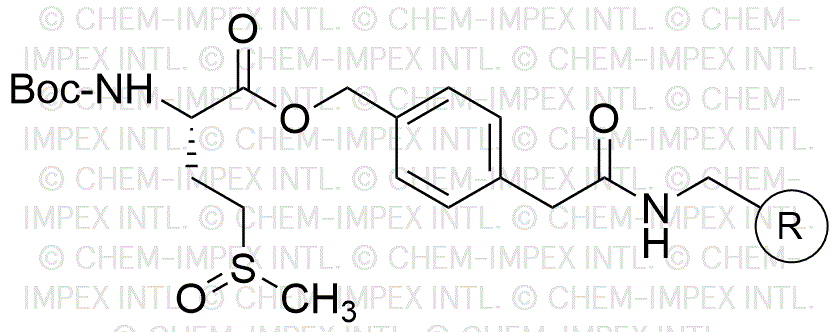Boc-L-methionine-sulfoxide 4-oxymethylphenylacetamidomethyl is widely utilized in research focused on:
- Peptide Synthesis: This compound serves as a key building block in the synthesis of peptides, allowing researchers to create specific sequences for therapeutic applications.
- Drug Development: Its unique structure aids in the design of novel drugs, particularly in the development of compounds targeting specific biological pathways.
- Bioconjugation: The compound can be used to attach biomolecules to surfaces or other molecules, enhancing the efficacy of drug delivery systems.
- Protein Modification: It is employed in modifying proteins to study their function and interactions, providing insights into cellular processes.
- Research in Cancer Therapy: The compound's properties make it a candidate for developing targeted therapies in oncology, potentially improving treatment outcomes.
General Information
Properties
Safety and Regulations
Applications
Boc-L-methionine-sulfoxide 4-oxymethylphenylacetamidomethyl is widely utilized in research focused on:
- Peptide Synthesis: This compound serves as a key building block in the synthesis of peptides, allowing researchers to create specific sequences for therapeutic applications.
- Drug Development: Its unique structure aids in the design of novel drugs, particularly in the development of compounds targeting specific biological pathways.
- Bioconjugation: The compound can be used to attach biomolecules to surfaces or other molecules, enhancing the efficacy of drug delivery systems.
- Protein Modification: It is employed in modifying proteins to study their function and interactions, providing insights into cellular processes.
- Research in Cancer Therapy: The compound's properties make it a candidate for developing targeted therapies in oncology, potentially improving treatment outcomes.
Documents
Safety Data Sheets (SDS)
The SDS provides comprehensive safety information on handling, storage, and disposal of the product.
Product Specification (PS)
The PS provides a comprehensive breakdown of the product’s properties, including chemical composition, physical state, purity, and storage requirements. It also details acceptable quality ranges and the product's intended applications.
Certificates of Analysis (COA)
Search for Certificates of Analysis (COA) by entering the products Lot Number. Lot and Batch Numbers can be found on a product’s label following the words ‘Lot’ or ‘Batch’.
Número de catálogo
Número de lote/lote
Certificates Of Origin (COO)
This COO confirms the country where the product was manufactured, and also details the materials and components used in it and whether it is derived from natural, synthetic, or other specific sources. This certificate may be required for customs, trade, and regulatory compliance.
Número de catálogo
Número de lote/lote
Safety Data Sheets (SDS)
The SDS provides comprehensive safety information on handling, storage, and disposal of the product.
DownloadProduct Specification (PS)
The PS provides a comprehensive breakdown of the product’s properties, including chemical composition, physical state, purity, and storage requirements. It also details acceptable quality ranges and the product's intended applications.
DownloadCertificates of Analysis (COA)
Search for Certificates of Analysis (COA) by entering the products Lot Number. Lot and Batch Numbers can be found on a product’s label following the words ‘Lot’ or ‘Batch’.
Número de catálogo
Número de lote/lote
Certificates Of Origin (COO)
This COO confirms the country where the product was manufactured, and also details the materials and components used in it and whether it is derived from natural, synthetic, or other specific sources. This certificate may be required for customs, trade, and regulatory compliance.

